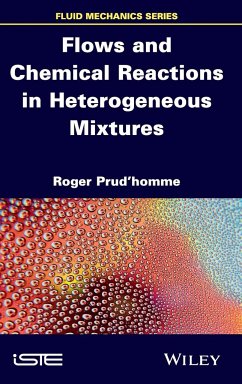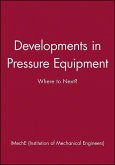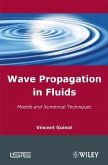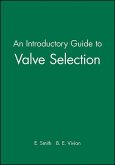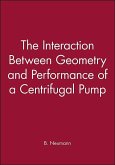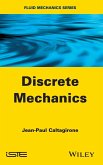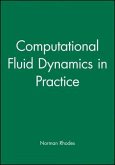Roger Prud'Homme
Flows and Chemical Reactions in Heterogeneous Mixtures
Roger Prud'Homme
Flows and Chemical Reactions in Heterogeneous Mixtures
- Gebundenes Buch
- Merkliste
- Auf die Merkliste
- Bewerten Bewerten
- Teilen
- Produkt teilen
- Produkterinnerung
- Produkterinnerung
"A continuation of two previous publications [by the author], respectively dealing with 'Flows and chemical reactions' and 'Flows and chemical reactions in homogeneous mixtures'"--Preface.
Andere Kunden interessierten sich auch für
![Developments in Pressure Equipment Developments in Pressure Equipment]() Imeche (Institution of Mechanical Engineers)Developments in Pressure Equipment261,99 €
Imeche (Institution of Mechanical Engineers)Developments in Pressure Equipment261,99 €![Wave Propagation in Fluids Wave Propagation in Fluids]() Vincent GuinotWave Propagation in Fluids231,99 €
Vincent GuinotWave Propagation in Fluids231,99 €![An Introductory Guide to Valve Selection An Introductory Guide to Valve Selection]() SmithAn Introductory Guide to Valve Selection126,99 €
SmithAn Introductory Guide to Valve Selection126,99 €![The Interaction Between Geometry and Performance of a Centrifugal Pump The Interaction Between Geometry and Performance of a Centrifugal Pump]() B. NeumannThe Interaction Between Geometry and Performance of a Centrifugal Pump397,99 €
B. NeumannThe Interaction Between Geometry and Performance of a Centrifugal Pump397,99 €![Discrete Mechanics Discrete Mechanics]() Jean-Paul CaltagironeDiscrete Mechanics187,99 €
Jean-Paul CaltagironeDiscrete Mechanics187,99 €![A Quick Guide to Pressure Relief Valves (Prvs) A Quick Guide to Pressure Relief Valves (Prvs)]() A Quick Guide to Pressure Relief Valves (Prvs)44,99 €
A Quick Guide to Pressure Relief Valves (Prvs)44,99 €![Computational Fluid Dynamics in Practice Computational Fluid Dynamics in Practice]() Computational Fluid Dynamics in Practice184,99 €
Computational Fluid Dynamics in Practice184,99 €-
-
-
"A continuation of two previous publications [by the author], respectively dealing with 'Flows and chemical reactions' and 'Flows and chemical reactions in homogeneous mixtures'"--Preface.
Hinweis: Dieser Artikel kann nur an eine deutsche Lieferadresse ausgeliefert werden.
Hinweis: Dieser Artikel kann nur an eine deutsche Lieferadresse ausgeliefert werden.
Produktdetails
- Produktdetails
- Verlag: Wiley
- Seitenzahl: 208
- Erscheinungstermin: 15. Dezember 2014
- Englisch
- Abmessung: 240mm x 161mm x 16mm
- Gewicht: 481g
- ISBN-13: 9781848217850
- ISBN-10: 1848217854
- Artikelnr.: 41536105
- Herstellerkennzeichnung
- Libri GmbH
- Europaallee 1
- 36244 Bad Hersfeld
- gpsr@libri.de
- Verlag: Wiley
- Seitenzahl: 208
- Erscheinungstermin: 15. Dezember 2014
- Englisch
- Abmessung: 240mm x 161mm x 16mm
- Gewicht: 481g
- ISBN-13: 9781848217850
- ISBN-10: 1848217854
- Artikelnr.: 41536105
- Herstellerkennzeichnung
- Libri GmbH
- Europaallee 1
- 36244 Bad Hersfeld
- gpsr@libri.de
Roger Prud'homme has been Emeritus Research Director at CNRS, in France, since 2004. His most recent research topics have included flames (premixed flame modeling and their behavior in microgravity), two phase flows (droplet combustion with condensation of the products, sound propagation in suspensions, vortex, chock wave structure) and the modeling of fluid interfaces. He has published 5 books, 7 contributions to volumes and 50 publications in international journals.
PREFACE ix
LIST OF MAIN SYMBOLS xv
CHAPTER 1. GENERATION OF MULTIPHASE FLOWS 1
1.1. Creation of suspensions of solid particles in a gaseous phase 1
1.1.1. Creation of a homogeneous suspension of starch particles 2
1.1.2. Soot formation 3
1.2. Creation of suspensions of bubbles in a liquid 5
1.2.1. Example of creation of a suspension of bubbles in a liquid 5
1.2.2. Influence of gravity on suspensions in pipes 7
1.2.3. Slug flows 8
1.3. Creation of suspensions of drops in a gas 9
1.3.1. Destabilization of fluid sheets and layers 10
1.3.2. Formation of droplets from filaments 22
1.3.3. Numerical simulation of primary atomization 32
1.3.4. Secondary atomization 42
CHAPTER 2. PROBLEMS AT THE SCALE OF A PARTICLE 47
2.1. Force exerted by a fluid on a spherical particle 48
2.1.1. Perfect incompressible fluid 48
2.1.2. Incompressible viscous fluid 51
2.2. Heat exchanges 59
2.3. Combustion of a drop of fuel in an oxidizing environment 61
CHAPTER 3. SIMPLIFIED MODEL OF A NON-REACTIVE FLOW WITH PARTICLES 65
3.1. Variables characterizing the flow 66
3.2. Balance equations 68
3.2.1. Balances for the particles 69
3.2.2. Balances for the gaseous phase 71
3.2.3. Entropy balance and phenomenological relations 71
3.3. Application to the linearized study of sound propagation in a
non-reactive dilute suspension 74
3.4. Two-phase dilute flows in nozzles 78
3.4.1. Flow with constant phase shifts 79
3.4.2. Numerical solutions 82
CHAPTER 4. SIMPLIFIED MODEL OF A REACTIVE FLOW WITH PARTICLES 85
4.1. Balance equations for a reactive fog 85
4.1.1. Balances for the droplets 86
4.1.2. Balances of the mixture 88
4.1.3. Gaseous balances 90
4.1.4. Entropy balance of the spray and phenomenological relations 90
4.1.5. Equations of the two-phase CEDRE solver 92
4.1.6. Modified equations to take account of an internal temperature
gradient of the drops: multi-layer model 93
4.2. Application to a spray flame 98
4.2.1. Application of a minimum model to the study of the threshold of
appearance of a pulsating flame 98
4.2.2. Application to the study of the resonant action of an acoustic wave
on a spray flame 102
CHAPTER 5. RADIATIVE PHENOMENA 105
5.1. Basic values and fundamental relations in radiative transfer 106
5.1.1. Definitions 106
5.1.2. Radiative Transfer Equation (RTE) 108
5.1.3. Radiative flux and power 110
5.1.4. Involvement of radiative heat transfer in the equations of
aerothermochemistry 113
5.1.5. Turbulence-radiation interaction (TRI) 118
5.1.6. Modeling of the radiative properties of gases 119
5.1.7. Modeling of the radiative properties of the particles 124
5.2. Application to the hypersonic flow of atmospheric re-entry 127
5.2.1. One-dimensional approximation for a re-entering body 128
5.2.2. 3D calculations for a body experiencing re-entry 130
5.3. Application to the boundary layer above a flat plate with soot
formation and radiative transfer 132
5.3.1. Recap on a boundary layer with diffusion 133
5.3.2. Reminders about the Emmons problem 136
5.3.3. Influence of soot and radiative transfer 142
5.4. Application to combustion of aluminum-based solid propellants 144
APPENDIX. CONCEPTS SURROUNDING THE HOPF BIFURCATION 149
BIBLIOGRAPHY 153
INDEX 173
LIST OF MAIN SYMBOLS xv
CHAPTER 1. GENERATION OF MULTIPHASE FLOWS 1
1.1. Creation of suspensions of solid particles in a gaseous phase 1
1.1.1. Creation of a homogeneous suspension of starch particles 2
1.1.2. Soot formation 3
1.2. Creation of suspensions of bubbles in a liquid 5
1.2.1. Example of creation of a suspension of bubbles in a liquid 5
1.2.2. Influence of gravity on suspensions in pipes 7
1.2.3. Slug flows 8
1.3. Creation of suspensions of drops in a gas 9
1.3.1. Destabilization of fluid sheets and layers 10
1.3.2. Formation of droplets from filaments 22
1.3.3. Numerical simulation of primary atomization 32
1.3.4. Secondary atomization 42
CHAPTER 2. PROBLEMS AT THE SCALE OF A PARTICLE 47
2.1. Force exerted by a fluid on a spherical particle 48
2.1.1. Perfect incompressible fluid 48
2.1.2. Incompressible viscous fluid 51
2.2. Heat exchanges 59
2.3. Combustion of a drop of fuel in an oxidizing environment 61
CHAPTER 3. SIMPLIFIED MODEL OF A NON-REACTIVE FLOW WITH PARTICLES 65
3.1. Variables characterizing the flow 66
3.2. Balance equations 68
3.2.1. Balances for the particles 69
3.2.2. Balances for the gaseous phase 71
3.2.3. Entropy balance and phenomenological relations 71
3.3. Application to the linearized study of sound propagation in a
non-reactive dilute suspension 74
3.4. Two-phase dilute flows in nozzles 78
3.4.1. Flow with constant phase shifts 79
3.4.2. Numerical solutions 82
CHAPTER 4. SIMPLIFIED MODEL OF A REACTIVE FLOW WITH PARTICLES 85
4.1. Balance equations for a reactive fog 85
4.1.1. Balances for the droplets 86
4.1.2. Balances of the mixture 88
4.1.3. Gaseous balances 90
4.1.4. Entropy balance of the spray and phenomenological relations 90
4.1.5. Equations of the two-phase CEDRE solver 92
4.1.6. Modified equations to take account of an internal temperature
gradient of the drops: multi-layer model 93
4.2. Application to a spray flame 98
4.2.1. Application of a minimum model to the study of the threshold of
appearance of a pulsating flame 98
4.2.2. Application to the study of the resonant action of an acoustic wave
on a spray flame 102
CHAPTER 5. RADIATIVE PHENOMENA 105
5.1. Basic values and fundamental relations in radiative transfer 106
5.1.1. Definitions 106
5.1.2. Radiative Transfer Equation (RTE) 108
5.1.3. Radiative flux and power 110
5.1.4. Involvement of radiative heat transfer in the equations of
aerothermochemistry 113
5.1.5. Turbulence-radiation interaction (TRI) 118
5.1.6. Modeling of the radiative properties of gases 119
5.1.7. Modeling of the radiative properties of the particles 124
5.2. Application to the hypersonic flow of atmospheric re-entry 127
5.2.1. One-dimensional approximation for a re-entering body 128
5.2.2. 3D calculations for a body experiencing re-entry 130
5.3. Application to the boundary layer above a flat plate with soot
formation and radiative transfer 132
5.3.1. Recap on a boundary layer with diffusion 133
5.3.2. Reminders about the Emmons problem 136
5.3.3. Influence of soot and radiative transfer 142
5.4. Application to combustion of aluminum-based solid propellants 144
APPENDIX. CONCEPTS SURROUNDING THE HOPF BIFURCATION 149
BIBLIOGRAPHY 153
INDEX 173
PREFACE ix
LIST OF MAIN SYMBOLS xv
CHAPTER 1. GENERATION OF MULTIPHASE FLOWS 1
1.1. Creation of suspensions of solid particles in a gaseous phase 1
1.1.1. Creation of a homogeneous suspension of starch particles 2
1.1.2. Soot formation 3
1.2. Creation of suspensions of bubbles in a liquid 5
1.2.1. Example of creation of a suspension of bubbles in a liquid 5
1.2.2. Influence of gravity on suspensions in pipes 7
1.2.3. Slug flows 8
1.3. Creation of suspensions of drops in a gas 9
1.3.1. Destabilization of fluid sheets and layers 10
1.3.2. Formation of droplets from filaments 22
1.3.3. Numerical simulation of primary atomization 32
1.3.4. Secondary atomization 42
CHAPTER 2. PROBLEMS AT THE SCALE OF A PARTICLE 47
2.1. Force exerted by a fluid on a spherical particle 48
2.1.1. Perfect incompressible fluid 48
2.1.2. Incompressible viscous fluid 51
2.2. Heat exchanges 59
2.3. Combustion of a drop of fuel in an oxidizing environment 61
CHAPTER 3. SIMPLIFIED MODEL OF A NON-REACTIVE FLOW WITH PARTICLES 65
3.1. Variables characterizing the flow 66
3.2. Balance equations 68
3.2.1. Balances for the particles 69
3.2.2. Balances for the gaseous phase 71
3.2.3. Entropy balance and phenomenological relations 71
3.3. Application to the linearized study of sound propagation in a
non-reactive dilute suspension 74
3.4. Two-phase dilute flows in nozzles 78
3.4.1. Flow with constant phase shifts 79
3.4.2. Numerical solutions 82
CHAPTER 4. SIMPLIFIED MODEL OF A REACTIVE FLOW WITH PARTICLES 85
4.1. Balance equations for a reactive fog 85
4.1.1. Balances for the droplets 86
4.1.2. Balances of the mixture 88
4.1.3. Gaseous balances 90
4.1.4. Entropy balance of the spray and phenomenological relations 90
4.1.5. Equations of the two-phase CEDRE solver 92
4.1.6. Modified equations to take account of an internal temperature
gradient of the drops: multi-layer model 93
4.2. Application to a spray flame 98
4.2.1. Application of a minimum model to the study of the threshold of
appearance of a pulsating flame 98
4.2.2. Application to the study of the resonant action of an acoustic wave
on a spray flame 102
CHAPTER 5. RADIATIVE PHENOMENA 105
5.1. Basic values and fundamental relations in radiative transfer 106
5.1.1. Definitions 106
5.1.2. Radiative Transfer Equation (RTE) 108
5.1.3. Radiative flux and power 110
5.1.4. Involvement of radiative heat transfer in the equations of
aerothermochemistry 113
5.1.5. Turbulence-radiation interaction (TRI) 118
5.1.6. Modeling of the radiative properties of gases 119
5.1.7. Modeling of the radiative properties of the particles 124
5.2. Application to the hypersonic flow of atmospheric re-entry 127
5.2.1. One-dimensional approximation for a re-entering body 128
5.2.2. 3D calculations for a body experiencing re-entry 130
5.3. Application to the boundary layer above a flat plate with soot
formation and radiative transfer 132
5.3.1. Recap on a boundary layer with diffusion 133
5.3.2. Reminders about the Emmons problem 136
5.3.3. Influence of soot and radiative transfer 142
5.4. Application to combustion of aluminum-based solid propellants 144
APPENDIX. CONCEPTS SURROUNDING THE HOPF BIFURCATION 149
BIBLIOGRAPHY 153
INDEX 173
LIST OF MAIN SYMBOLS xv
CHAPTER 1. GENERATION OF MULTIPHASE FLOWS 1
1.1. Creation of suspensions of solid particles in a gaseous phase 1
1.1.1. Creation of a homogeneous suspension of starch particles 2
1.1.2. Soot formation 3
1.2. Creation of suspensions of bubbles in a liquid 5
1.2.1. Example of creation of a suspension of bubbles in a liquid 5
1.2.2. Influence of gravity on suspensions in pipes 7
1.2.3. Slug flows 8
1.3. Creation of suspensions of drops in a gas 9
1.3.1. Destabilization of fluid sheets and layers 10
1.3.2. Formation of droplets from filaments 22
1.3.3. Numerical simulation of primary atomization 32
1.3.4. Secondary atomization 42
CHAPTER 2. PROBLEMS AT THE SCALE OF A PARTICLE 47
2.1. Force exerted by a fluid on a spherical particle 48
2.1.1. Perfect incompressible fluid 48
2.1.2. Incompressible viscous fluid 51
2.2. Heat exchanges 59
2.3. Combustion of a drop of fuel in an oxidizing environment 61
CHAPTER 3. SIMPLIFIED MODEL OF A NON-REACTIVE FLOW WITH PARTICLES 65
3.1. Variables characterizing the flow 66
3.2. Balance equations 68
3.2.1. Balances for the particles 69
3.2.2. Balances for the gaseous phase 71
3.2.3. Entropy balance and phenomenological relations 71
3.3. Application to the linearized study of sound propagation in a
non-reactive dilute suspension 74
3.4. Two-phase dilute flows in nozzles 78
3.4.1. Flow with constant phase shifts 79
3.4.2. Numerical solutions 82
CHAPTER 4. SIMPLIFIED MODEL OF A REACTIVE FLOW WITH PARTICLES 85
4.1. Balance equations for a reactive fog 85
4.1.1. Balances for the droplets 86
4.1.2. Balances of the mixture 88
4.1.3. Gaseous balances 90
4.1.4. Entropy balance of the spray and phenomenological relations 90
4.1.5. Equations of the two-phase CEDRE solver 92
4.1.6. Modified equations to take account of an internal temperature
gradient of the drops: multi-layer model 93
4.2. Application to a spray flame 98
4.2.1. Application of a minimum model to the study of the threshold of
appearance of a pulsating flame 98
4.2.2. Application to the study of the resonant action of an acoustic wave
on a spray flame 102
CHAPTER 5. RADIATIVE PHENOMENA 105
5.1. Basic values and fundamental relations in radiative transfer 106
5.1.1. Definitions 106
5.1.2. Radiative Transfer Equation (RTE) 108
5.1.3. Radiative flux and power 110
5.1.4. Involvement of radiative heat transfer in the equations of
aerothermochemistry 113
5.1.5. Turbulence-radiation interaction (TRI) 118
5.1.6. Modeling of the radiative properties of gases 119
5.1.7. Modeling of the radiative properties of the particles 124
5.2. Application to the hypersonic flow of atmospheric re-entry 127
5.2.1. One-dimensional approximation for a re-entering body 128
5.2.2. 3D calculations for a body experiencing re-entry 130
5.3. Application to the boundary layer above a flat plate with soot
formation and radiative transfer 132
5.3.1. Recap on a boundary layer with diffusion 133
5.3.2. Reminders about the Emmons problem 136
5.3.3. Influence of soot and radiative transfer 142
5.4. Application to combustion of aluminum-based solid propellants 144
APPENDIX. CONCEPTS SURROUNDING THE HOPF BIFURCATION 149
BIBLIOGRAPHY 153
INDEX 173

